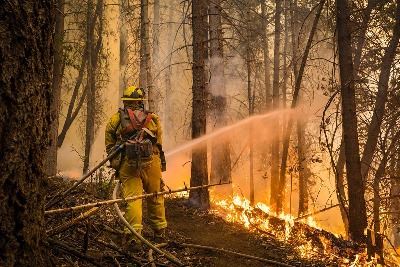Noting that President Biden’s infrastructure bill allocates $3.3 billion for things like firefighter raises, prescribed fire and defending communities against wildfire, Kylie Mohr contacted FSEEE Executive Director Andy Stahl for an article in High Country News.
Mohr also interviewed Zack Bashoor, who was 19 years old when he joined the U.S. Forest Service to fight wildfires, expecting to pursue a career in firefighting. But after three summers of the dangerous work, he left firefighting to become a resource forester at a lumber mill. Many of his peers also left the profession, citing a toxic work culture and low compensation for a physically demanding and risky job.
“There’s this conundrum where a lot of brilliant young people come in and they eventually end up leaving,” Bashoor told Mohr. “They find something better to do that isn’t as dangerous and pays a little more money.”
Biden’s infrastructure bill aims to change that by raising wages for wildland firefighters and making some positions year-round, and Mohr’s article notes positive responses to the bill from people like Keala Hagmann, a research ecologist with the University of Washington, and Lenya Quinn-Davidson, a fire advisor with the University of California Cooperative Extension in Humboldt County.
“It is encouraging to see additional funding being made available for restoration and climate- and wildfire-adaptation of forest ecosystems,” said Hagmann.
“It’s time to radically increase the scale of the work we’re doing,” Quinn-Davidson said. “We’ve never seen the investments we need to get ahead. It’s important for us to dump huge amounts of funding on this work and build the workforce to do it.”
Andy is less optimistic that the infrastructure bill will have a significant impact on the Forest Service firefighting force: “I don’t know who these people are that Congress thinks are just beating down the doors saying, ‘This is the job I want, or are beating down the doors saying they want any job at all,” he told Mohr.
Other experts are also skeptical, Mohr reports. Matt Wibbenmeyer, an environmental economist with Resources for the Future, said even more money is needed, and the Forest Service estimates it needs $5 billion to $6 billion a year over the next 10 years to reduce flammable forest fuels in high priority areas. “It’s a step in the right direction, but what we really need here is an order of magnitude increase in how much of this risk reduction we’re investing in,” Wibbenmeyer said.



I’m curious and concerned about what was referred to as a “toxic work culture” in wildland fire suppression in the article above by one ex-wildland firefighter. Limited career advancement potential in wildland fire and relatively poor base wages (however great amounts of overtime pay) have always been the case. In addition, although not mentioned in the article, recent increasingly impracticable minimum required annual duty tours. For instance, most jump bases now require a minimum tour of 5-6 months. That is no enough to support a person year-round and may well never lead to a full time career job, and it also precludes college students, teachers, and many others from being jumpers. Such people used to be the mainstay of jumper staff.